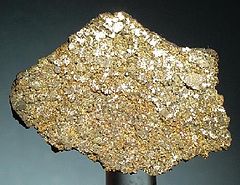H chondrite
| H chondrite | |
|---|---|
| — Group — | |
 Weston meteorite, H4 | |
| Type | Chondrite |
| Structural classification | ? |
| Class | Ordinary chondrite |
| Subgroups |
|
| Parent body | Possibly 6 Hebe, less likely 3 Juno & 7 Iris |
| Composition | Iron ~25–31%, bronzite (an orthopyroxene), olivine (with characteristic fayalite (Fa) content 16 to 20 mol%), nickel-iron 15–19%, troilite 5% |
| Petrologic type | 3 (~2.5%), 5 (40%), 4 & 6 (57.5%) |
| Alternative names | Bronzite chondrites, Olivine bronzite chondrites |
 Nuevo Mercurio, H5 | |
The H type ordinary chondrites are the most common type of meteorite, accounting for approximately 40% of all those catalogued, 46% of the ordinary chondrites, and 44% of all chondrites.[1] The ordinary chondrites are thought to have originated from three parent asteroids, whose fragments make up the H chondrite, L chondrite and LL chondrite groups respectively.[2]
Name
[edit]The name comes from their High iron abundance, with respect to other ordinary chondrites.
Historically, the H chondrites have been named bronzite chondrites or olivine bronzite chondrites for the dominant minerals, but these terms are now obsolete.
Parent body
[edit]A probable parent body for this group is the S-type asteroid 6 Hebe, with less likely candidates being 3 Juno and 7 Iris.[3] It is supposed that these meteorites arise from impacts onto small near-Earth asteroids broken off from 6 Hebe in the past, rather than originating from 6 Hebe directly.
The H chondrites have very similar trace element abundances and Oxygen isotope ratios to the IIE iron meteorites, making it likely that they both originate from the same parent body.
Iron
[edit]Their high iron abundance is about 25–31% by weight. Over half of this is present in metallic form, making these meteorites strongly magnetic despite the stony chondritic appearance.
Mineralogy
[edit]The most abundant minerals are bronzite (an orthopyroxene), and olivine. Characteristic is the fayalite (Fa) content of the olivine of 16 to 20 mol%. They contain also 15–19% of nickel-iron metal and about 5% of troilite. The majority of these meteorites have been significantly metamorphosed, with over 40% being in petrologic class 5, most of the rest in classes 4 and 6. Only a few (about 2.5%) are of the largely unaltered petrologic class 3.
Gallery
[edit]-
Gao-Guenie, H5
-
H5 Dar Bou Nali South Morocco
See also
[edit]References
[edit]- ^ "Natural History Museum, meteorite catalogue". Archived from the original on 2006-05-03. Retrieved 2005-11-29.
- ^ NASA (YouTube) – Dr. David Kring – Asteroid Initiative Workshop Cosmic Explorations Speakers Session
- ^ M. J. Gaffey & S. L. Gilbert Asteroid 6 Hebe: The probable parent body of the H-Type ordinary chondrites and the IIE iron meteorites, Meteoritics & Planetary Science, Vol. 33, p. 1281 (1998).
External links
[edit]- The Catalogue of Meteorites Archived 2006-05-03 at the Wayback Machine


